Ray is a cartilaginous fish, so it is closely related sharks, which have no bones. Their skeleton is made of cartilage, which is a tough, fibrous substance, not nearly as hard as bone. Rays exist throughout the oceans, from the tropics to the cold waters around the Arctic and Antarctica. They occur at all depths, from the intertidal zone down to the deep sea. Among the various species of rays in the world, these are 15 Types of Ocean Rays you need to know.
See also:
- Effects of Sea Level Rise
- Sea Salt Facts
- Ocean Problems
- Ocean Animals
- Endangered Fish Species
- Ocean Sediments
1. Sixgill Stingray
 The sixgill stingray (Hexatrygon bickelli) is a species of stingray that lives in Indo-Pacific. This ray grows up to 1.7 m long. It has a rounded pectoral fin disc and a long, triangular, and flexible snout filled with a gelatinous substance. Its color is brownish above and white below, and lacks dermal denticles. This ray is a bottom-dwelling species that typically inhabits upper continental slopes and seamounts at depths of 500–1,120 m. However, it occasionally ventures into shallower water, with one ray observed feeding at a depth of 30 m off Japan. It commonly lives around sandy, muddy, or rocky bottom substrates.
The sixgill stingray (Hexatrygon bickelli) is a species of stingray that lives in Indo-Pacific. This ray grows up to 1.7 m long. It has a rounded pectoral fin disc and a long, triangular, and flexible snout filled with a gelatinous substance. Its color is brownish above and white below, and lacks dermal denticles. This ray is a bottom-dwelling species that typically inhabits upper continental slopes and seamounts at depths of 500–1,120 m. However, it occasionally ventures into shallower water, with one ray observed feeding at a depth of 30 m off Japan. It commonly lives around sandy, muddy, or rocky bottom substrates.
See also:
2. Deepwater Stingray
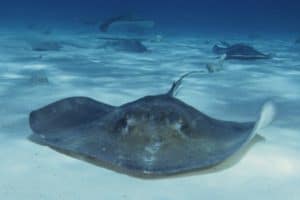 The deepwater stingray (Plesiobatis daviesi) is the only member of the family Plesiobatidae. It inhabits the Indo-Pacific, typically over fine sediments on the upper continental slope at depths of 275–680 m. This species can reach 2.7 m in length and 1.5 m in width. This ray owns an oval pectoral fin disc with a long, flexible, broad-angled snout. Its body color is dark above and white below, and its skin is almost full of tiny dermal denticles. Deepwater Stingray preys on crustaceans, cephalopods, and bony fishes. They may hunt both on the sea floor and well above it in open water.
The deepwater stingray (Plesiobatis daviesi) is the only member of the family Plesiobatidae. It inhabits the Indo-Pacific, typically over fine sediments on the upper continental slope at depths of 275–680 m. This species can reach 2.7 m in length and 1.5 m in width. This ray owns an oval pectoral fin disc with a long, flexible, broad-angled snout. Its body color is dark above and white below, and its skin is almost full of tiny dermal denticles. Deepwater Stingray preys on crustaceans, cephalopods, and bony fishes. They may hunt both on the sea floor and well above it in open water.
See also:
3. Round Ribbontail Ray
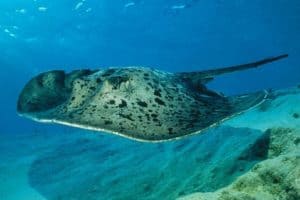 The round ribbontail ray (Taeniura meyeni) is a species of stingray that lives nearshore waters of the tropical Indo-Pacific, as well as off islands in the eastern Pacific. It is a bottom-dwelling species that inhabits lagoons, estuaries, and reefs, generally at a depth of 20–60 m. This ray reaches 1.8 m across. It has a thick, rounded pectoral fin disc covered by small tubercles on top, and a relatively short tail bearing a deep ventral fin fold. Round ribbontail ray is an active predator of small, benthic molluscs, crustaceans, and bony fishes. The threats for this slow-reproducing species is commercial fishing, both targeted and as bycatch, and habitat degradation across much of its range.
The round ribbontail ray (Taeniura meyeni) is a species of stingray that lives nearshore waters of the tropical Indo-Pacific, as well as off islands in the eastern Pacific. It is a bottom-dwelling species that inhabits lagoons, estuaries, and reefs, generally at a depth of 20–60 m. This ray reaches 1.8 m across. It has a thick, rounded pectoral fin disc covered by small tubercles on top, and a relatively short tail bearing a deep ventral fin fold. Round ribbontail ray is an active predator of small, benthic molluscs, crustaceans, and bony fishes. The threats for this slow-reproducing species is commercial fishing, both targeted and as bycatch, and habitat degradation across much of its range.
See also:
4. Striped Panray
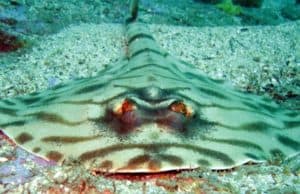 The striped panray (Zanobatus schoenleinii) is a species of ray in the family Zanobatidae that is native to the warm East Atlantic Ocean, ranging from Morocco, through the Gulf of Guinea to Angola. Adults can reach up to 40–50 cm long and the likely maximum length is about 60 cm. It primarily lives over sandy bottoms at depths of less than 15 m, but may occur deeper at 60–100 m. The upper part of the body is brownish with a distinct dark blotched and barred pattern. This ray feeds on benthic invertebrates. It is an ovoviviparous species and gives birth to 1–4 young that are about 19 cm long.
The striped panray (Zanobatus schoenleinii) is a species of ray in the family Zanobatidae that is native to the warm East Atlantic Ocean, ranging from Morocco, through the Gulf of Guinea to Angola. Adults can reach up to 40–50 cm long and the likely maximum length is about 60 cm. It primarily lives over sandy bottoms at depths of less than 15 m, but may occur deeper at 60–100 m. The upper part of the body is brownish with a distinct dark blotched and barred pattern. This ray feeds on benthic invertebrates. It is an ovoviviparous species and gives birth to 1–4 young that are about 19 cm long.
See also:
5. Short-tail Stingray
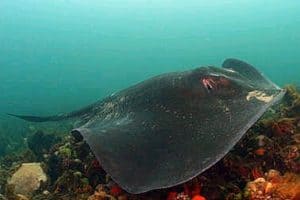 The short-tail stingray (Dasyatis brevicaudata) is a species of stingray in the family Dasyatidae. It inhabits the southern Africa, typically offshore at a depth of 180–480 m, and off southern Australia and New Zealand, from the intertidal zone to a depth of 156 m. It is mostly bottom-dwelling in nature and lives across a range of habitats from estuaries to reefs, but also often swims into open water. This species is largest stingray in the world with the heavy-body grows upwards of 2.1 m across and 350 kg in weight. It has a plain-colored and diamond-shaped pectoral fin disc. The pectoral fin disc is lack of dermal denticles even in adults and has white pores beside the head on either side. Its tail is generally shorter than the disc and thick at the base.
The short-tail stingray (Dasyatis brevicaudata) is a species of stingray in the family Dasyatidae. It inhabits the southern Africa, typically offshore at a depth of 180–480 m, and off southern Australia and New Zealand, from the intertidal zone to a depth of 156 m. It is mostly bottom-dwelling in nature and lives across a range of habitats from estuaries to reefs, but also often swims into open water. This species is largest stingray in the world with the heavy-body grows upwards of 2.1 m across and 350 kg in weight. It has a plain-colored and diamond-shaped pectoral fin disc. The pectoral fin disc is lack of dermal denticles even in adults and has white pores beside the head on either side. Its tail is generally shorter than the disc and thick at the base.
See also:
6. Roughtail Stingray
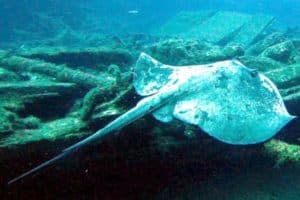 The roughtail stingray (Dasyatis centroura) is a species of stingray in the whip-tail stingray family, Dasyatidae. It has separate populations in coastal waters of the northwestern, eastern, and southwestern Atlantic Ocean. This bottom-dwelling species typically inhabits sandy or muddy areas with patches of invertebrate cover, at a depth of 15–50 m. It’s the largest whip-tail stingray in the Atlantic which grows up to 2.6 m across and 360 kg in weight. The ray’s body has a plain color and an angular, diamond-shaped pectoral fin disc. Its whip-tail is long and bearing a subtle fin fold underneath. The roughtail stingray is a generalist predator that preys on various benthic invertebrates and bony fishes.
The roughtail stingray (Dasyatis centroura) is a species of stingray in the whip-tail stingray family, Dasyatidae. It has separate populations in coastal waters of the northwestern, eastern, and southwestern Atlantic Ocean. This bottom-dwelling species typically inhabits sandy or muddy areas with patches of invertebrate cover, at a depth of 15–50 m. It’s the largest whip-tail stingray in the Atlantic which grows up to 2.6 m across and 360 kg in weight. The ray’s body has a plain color and an angular, diamond-shaped pectoral fin disc. Its whip-tail is long and bearing a subtle fin fold underneath. The roughtail stingray is a generalist predator that preys on various benthic invertebrates and bony fishes.
See also:
7. Broad Stingray
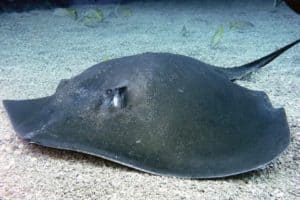 The broad stingray (Dasyatis lata), also known as the brown stingray or Hawaiian stingray, is a species of stingray in the family Dasyatidae. This species of stingray is native to the inshore waters of the Hawaiian Islands. It’s a benthic fish that typically occurs on sandy or muddy flats at depths greater than 15 m. This stingray usually grows to 1 m across and has a wide, diamond-shaped pectoral fin disc with a protruding snout tip and a long tail with a ventral fin fold. It actively forages for bottom-dwelling invertebrates and bony fishes near the boundaries of reefs at night. It digs large pits to uncover buried prey and is often followed by opportunists such as jacks.
The broad stingray (Dasyatis lata), also known as the brown stingray or Hawaiian stingray, is a species of stingray in the family Dasyatidae. This species of stingray is native to the inshore waters of the Hawaiian Islands. It’s a benthic fish that typically occurs on sandy or muddy flats at depths greater than 15 m. This stingray usually grows to 1 m across and has a wide, diamond-shaped pectoral fin disc with a protruding snout tip and a long tail with a ventral fin fold. It actively forages for bottom-dwelling invertebrates and bony fishes near the boundaries of reefs at night. It digs large pits to uncover buried prey and is often followed by opportunists such as jacks.
See also:
8. Spiny Butterfly Ray
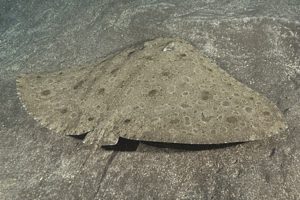
The spiny butterfly ray or giant butterfly ray (Gymnura altavela) is a species of butterfly ray family, Gymnuridae. It is native to the shallow coastal waters of the Atlantic Ocean. It occurs in shallow brackish and coastal waters over soft sandy or muddy substrates, at a depth of 5–100 m. The spiny butterfly ray has a very broad, lozenge-shaped pectoral fin disk much wider than its length, with concave front margins and abruptly rounded corners. Its snout is short and blunt. The tail is short and slender, measuring a quarter the disk width, with upper and lower fin folds. The color of the body is dark brown above, sometimes with small lighter or darker spots and blotches in a marbled pattern, and white below.
See also:
9. Smooth Butterfly Ray
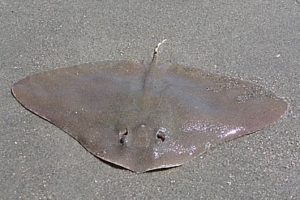 The smooth butterfly ray (Gymnura micrura) is a species of family Gymnuridae. They inhabit the western and eastern parts of the Atlantic Ocean and the Gulf of Mexico. They are generally found in neritic waters but are also known to enter brackish estuaries and hypersaline lagoons. The width of the adults is about 50 cm for a female and about 42 cm for a male. It’s a broad diamond-shaped ray with a short tail that has low dorsal and ventral fin folds. The ventral side is usually white and can contain a rusty or bronze coloration, while the dorsal side can be gray light green, brown, and also not uniform in color. These rays feed mainly on Teleosts and crustaceans, but also consume bivalve mussels and polychaetes.
The smooth butterfly ray (Gymnura micrura) is a species of family Gymnuridae. They inhabit the western and eastern parts of the Atlantic Ocean and the Gulf of Mexico. They are generally found in neritic waters but are also known to enter brackish estuaries and hypersaline lagoons. The width of the adults is about 50 cm for a female and about 42 cm for a male. It’s a broad diamond-shaped ray with a short tail that has low dorsal and ventral fin folds. The ventral side is usually white and can contain a rusty or bronze coloration, while the dorsal side can be gray light green, brown, and also not uniform in color. These rays feed mainly on Teleosts and crustaceans, but also consume bivalve mussels and polychaetes.
See also:
10. Common Eagle Ray
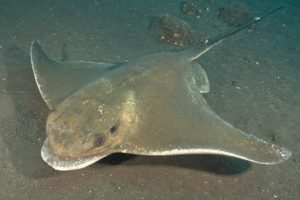
The common eagle ray (Myliobatis aquila) is a species of fish in the family Myliobatidae. It inhabits the eastern Atlantic Ocean (The North Sea to South Africa), the Mediterranean Sea and the south-western Indian Ocean. This ray reaches up to 183 cm long and has a disc width up to 80 cm. It has a rhomboidal disc with a pair of large, triangular pectoral fins extending on either side and a single dorsal fin. The snout is round and the tail is slender. The ventral surface is white while the dorsal surface is brown or black. The species largely feeds on crustaceans and bivalve mollusks by digging up the seabed.
See also:
11. Bat Ray
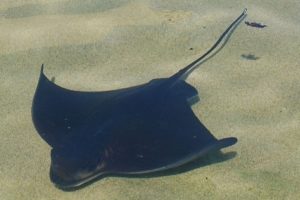 The bat ray (Myliobatis californica) is an eagle ray that occurs in muddy or sandy sloughs, estuaries and bays, kelp beds and rocky-bottomed shoreline in the eastern Pacific Ocean, between the Oregon coast and the Gulf of California. The largest wingspan can grow to 1.8 m. The average mass ranges from 9.07–13.61 kg. The main diet is mollusks, crustaceans and small fish on the seabed. This ray uses its winglike pectoral fins to move sand and expose prey animals. Bat ray is an ovoviviparous species. The pups emerge with the pectoral fins wrapped around the body.
The bat ray (Myliobatis californica) is an eagle ray that occurs in muddy or sandy sloughs, estuaries and bays, kelp beds and rocky-bottomed shoreline in the eastern Pacific Ocean, between the Oregon coast and the Gulf of California. The largest wingspan can grow to 1.8 m. The average mass ranges from 9.07–13.61 kg. The main diet is mollusks, crustaceans and small fish on the seabed. This ray uses its winglike pectoral fins to move sand and expose prey animals. Bat ray is an ovoviviparous species. The pups emerge with the pectoral fins wrapped around the body.
See also:
12. Spotted Eagle Ray
 The spotted eagle ray (Aetobatus narinari) is a member of the eagle ray family, Myliobatidae. It occurs globally in tropical regions, including the Atlantic, Pacific and Indian Oceans. This ray has a dark dorsal surface covered in white spots or rings. Mature spotted eagle rays can reach the length up to 5 meters. The largest has a wingspan of up to 3 meters and a mass of 230 kilograms. Spotted eagle rays commonly feed on small fish and crustaceans, and will sometimes dig with their snouts to look for food buried in the sand of the sea bed.
The spotted eagle ray (Aetobatus narinari) is a member of the eagle ray family, Myliobatidae. It occurs globally in tropical regions, including the Atlantic, Pacific and Indian Oceans. This ray has a dark dorsal surface covered in white spots or rings. Mature spotted eagle rays can reach the length up to 5 meters. The largest has a wingspan of up to 3 meters and a mass of 230 kilograms. Spotted eagle rays commonly feed on small fish and crustaceans, and will sometimes dig with their snouts to look for food buried in the sand of the sea bed.
See also:
13. Round Stingray
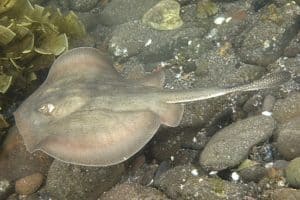
Round stingray (Urobatis halleri) is a species of round ray, family Urotrygonidae. It inhabits the coastal waters of the eastern Pacific Ocean. It is a small, common ray that feeds primarily on benthic invertebrates. The round stingray has a nearly round pectoral fin disc and is brown or grayish brown in color, with pale yellow spots or reticulations. It has a short and stout tail, and a long, thick, serrated stinging spine. Round stingrays use their pectoral disc and mouths to dig large pits to uncover buried prey.
See also:
14. Reef Manta Ray
 Reef manta ray (Manta alfredi) is a species of ray in the family Mobulidae. It’s the second-largest ray after the giant oceanic manta ray. This ray has a widespread distribution in tropical and subtropical parts of the Indo-Pacific. Reef manta rays are 3 to 3.5 m in average width with the maximum size of about 5.5 m. It has large, triangular pectoral fins on either side of the disc. At the front, it has a pair of cephalic fins which can be rolled up in a spiral for swimming or can be flared out to channel water into the large, forward-pointing, rectangular mouth when the animal is feeding.
Reef manta ray (Manta alfredi) is a species of ray in the family Mobulidae. It’s the second-largest ray after the giant oceanic manta ray. This ray has a widespread distribution in tropical and subtropical parts of the Indo-Pacific. Reef manta rays are 3 to 3.5 m in average width with the maximum size of about 5.5 m. It has large, triangular pectoral fins on either side of the disc. At the front, it has a pair of cephalic fins which can be rolled up in a spiral for swimming or can be flared out to channel water into the large, forward-pointing, rectangular mouth when the animal is feeding.
See also:
15. Giant Oceanic Manta Ray
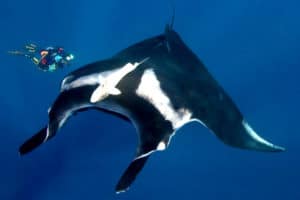 The giant oceanic manta ray (Manta birostris) is a species of ray in the family Mobulidae. It’s the largest type of ray in the world. They are typically found in tropical and subtropical waters, but can also occur in temperate waters. The giant oceanic manta ray can grow to a disc size of up to 7 m with a weight of about 1,350 kg, but the average size is about 4.5 m. The dorsal surface is deep dark and the two white areas are well marked without gradient effect. This species is a filter feeder that consumes large quantities of zooplankton in the form of shrimp, krill, and planktonic crabs.
The giant oceanic manta ray (Manta birostris) is a species of ray in the family Mobulidae. It’s the largest type of ray in the world. They are typically found in tropical and subtropical waters, but can also occur in temperate waters. The giant oceanic manta ray can grow to a disc size of up to 7 m with a weight of about 1,350 kg, but the average size is about 4.5 m. The dorsal surface is deep dark and the two white areas are well marked without gradient effect. This species is a filter feeder that consumes large quantities of zooplankton in the form of shrimp, krill, and planktonic crabs.
See also
- Endangered Species of the Ocean
- Conservation of Dolphins
- Endangered Dolphin Species
- List of Marine Invertebrates
- Major Threats to Marine Habitats
Those are 15 Types of Ocean Rays you won’t regret knowing. The wide distribution and diversity make them important in nearly all marine ecosystems, with each species possessing its own distinctive niche.